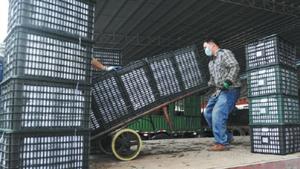 Workers unload fruit imported from ASEAN member states at a market in Pingxiang, the Guangxi Zhuang autonomous region. (PHOTO / XINHUA)
Workers unload fruit imported from ASEAN member states at a market in Pingxiang, the Guangxi Zhuang autonomous region. (PHOTO / XINHUA)
China will lead a gradual U-shaped regional economic recovery, which will help anchor production and confidence in neighboring countries aided by the adoption of a wide range of stimulus packages to contain the novel coronavirus epidemic, the head of a leading international research organization told China Daily in an exclusive interview on Wednesday.
A U-shaped recovery is one in which the economy gradually climbs out of a recessionary environment.
All economies in the ASEAN+3 region, the Association of Southeast Asian Nations (ASEAN) plus China, Japan and South Korea, could return to positive growth in 2021, and the region as a whole is expected to expand by 6.2 percent next year, led by China, said Toshinori Doi, director of the ASEAN+3 Macroeconomic Research Office (AMRO), which monitors macroeconomic and financial stability in the region.
China can play an important role to lead and support the region's economic recovery by resuming connectivity in trade and investment with regional economies and regaining regional demand
Toshinori Doi, Director of the ASEAN+3 Macroeconomic Research Office
ALSO READ: China's economy eyes rebound after Q1 virus pains
"China can play an important role to lead and support the region's economic recovery by resuming connectivity in trade and investment with regional economies and regaining regional demand," said Doi. "But this trajectory depends largely on how effectively the regional and global economies can contain the virus."
AMRO expects the region's economy to slow sharply to 0.2 percent this year. It has already shaved 3 percentage points off the growth forecast compared to a month ago.
As the COVID-19 outbreak has been nearly brought under control in China, more than half of the companies, particularly the export-oriented ones, have achieved around 80 percent of production utilization, said AMRO.
China's resumption of production will help anchor regional production and confidence, the director said. The region's electronics and semiconductor industries-spurred by 5G and artificial intelligence development, petroleum and chemicals from energy consumption-and textile and garment sectors will benefit from the resumption of manufacturing in China.
Besides, China's plan to increase infrastructure spending will also benefit commodity exporters in the region, Doi said.
"We expect China to carry out large infrastructure investment, such as transportation in the upcoming stimulus package. The country's demand for mining products will benefit mining exporters in the ASEAN, such as Indonesia, Malaysia, Laos, Myanmar and Vietnam."
On the shocks, the AMRO director said the pandemic has disrupted the ASEAN+3 supply chain and affected derived demand within the region.
In the post-pandemic period, efforts are likely to be focused on improving the robustness of the regional supply chain by diversifying the production of key intermediate and final products to more countries, to mitigate the risk of such disruptions.
"Regional cooperation and integration should continue among the ASEAN+3 countries as a counterweight against the rise of protectionism globally. The region should affirm its strong commitment to the rules-based multilateral trading system, which is under stress," Doi said.
ASEAN became China's largest goods trading partner in April this year. As China becomes more advanced in manufacturing and services, some labor-intensive manufacturing activities will be relocated to ASEAN member states with lower wages such as Vietnam, Laos, Cambodia and Myanmar.
China can work with other ASEAN+3 countries to boost trade and investment by strengthening regional trade integration, said Doi. "China can continue to work closely with ASEAN to conclude and ratify the Regional Comprehensive Economic Partnership to enlarge trade and investment among regional economies, adhering to the rulesbased trade policies and support multilateral trade mechanism against the strong wave of anti-globalization."
"On a brighter note, the ASEAN+3 economies remain fundamentally strong and resilient," Doi said. The strong fundamentals and policy buffers have made the regional economies more resilient to volatility shocks, including large capital outflows from the region in the past few months.
Premier Li Keqiang on April 14 proposed opening a "fast-track lane" for essential personnel on urgent visits in the fields of commerce, logistics, production and technological services among the countries in the region, according to a report from Xinhua News Agency.
READ MORE: More policies announced to boost economy
Li also pointed out that ASEAN+3 countries need to leverage their strengths in economic complementarity and strong business ties to further ease tariffs, eliminate barriers, boost the flow of trade and investment, and keep markets open to each other, the report said.
"As beneficiaries and supporters of trade and investment liberalization, Asian economies will continue to play the role of a global growth engine during and after the pandemic. We applaud the strong signals sent out by the Special ASEAN +3 Summit in April, that relevant countries would take measures to enhance regional economic stability and resilience, promote regional trade development, and make good use of the Regional Financial Arrangement," said Zhou Xiaochuan, vice-chairman of the Boao Forum for Asia and former governor of the People's Bank of China, the central bank.


